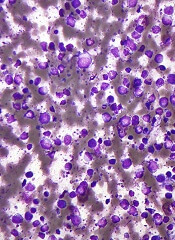
LUGANO—The phase 1, first-in-human study of the novel SYK inhibitor TAK-659 is showing “good early evidence” of antitumor activity in patients with lymphoma, according to investigators.
The agent also appears to be fairly well tolerated, with 10 categories of adverse events occurring in 2 or more patients.
Adam M. Petrich, MD, of Northwestern University in Evanston, Illinois, presented results from this ongoing study at the 13th International Congress on Malignant Lymphoma (13-ICML) as abstract 039.*
The study is supported by Millennium Pharmaceuticals, Inc., a wholly owned subsidiary of Takeda Pharmaceutical Company Limited.
Dr Petrich said the B-cell receptor signaling pathway is “very fertile ground with respect to development for novel targeting, particularly of B-cell malignancies, and SYK—the spleen tyrosine kinase—is an integral component of this.”
Investigators believe SYK has implications beyond B-cell lymphoma, including EBV-related malignancies, solid tumors, and myeloid leukemias.
Preclinical findings
In vitro experiments with TAK-659 showed “profound inhibition” of both SYK and FLT3, as indicated by the low IC50 levels, Dr Petrich said.
He also pointed out that the EC50 levels compare favorably to ibrutinib and idelalisib, with generally lower numbers in a broad panel of diffuse large B-cell lymphoma (DLBCL), follicular lymphoma (FL), and chronic lymphocytic leukemia.
In animal models, TAK-659 exhibited a dose-dependent tumor-inhibitory property.
“And if we look at both germinal center B and non-germinal center B subtypes of large-cell lymphoma, we see activity across both types,” Dr Petrich said.
Phase 1 study
Investigators are currently conducting the phase 1 study, which is a standard 3+3 dose-escalation schema. The data cutoff for the ICML presentation was April 13, although the dose-escalation phase was still underway, and the maximum tolerated dose was not yet reached.
Based on preclinical data, the team projected the efficacious dose for humans to be approximately 600 to 1200 mg per day. Patients were started at 60 mg, and, at the next planned step of 120 mg, 2 patients developed asymptomatic lipase elevations.
“For that reason, we revised the protocol, allowed for those to not be considered dose-limiting toxicities, and explored intermediate doses,” Dr Petrich explained.
So the protocol now includes intermediate doses of 80 and 100 mg. Dr Petrich’s presentation focused on the 4 doses—60, 80, 100, and 120 mg taken orally once daily.
He said the observed human clearance of TAK-659 was approximately 3- to 4-fold lower than predicted based on the mouse pharmacokinetic (PK) data, which led to steady-state area under the curve values 3- to 4-fold higher in humans than predicted.
Patient demographics
The investigators enrolled 21 patients, 12 with solid tumors, 6 with DLBCL, and 3 with FL. The median age was 60 years, 66% were male, and 62% had received 4 or more prior therapies.
The median number of TAK-659 treatment cycles was 2 (range, 1–10), and 5 patients are still on active treatment. Dr Petrich pointed out that 4 of the 5 longest-treated patients have DLBCL, and “the record holder with DLBCL is about to celebrate 1 year on therapy.”
Safety
“The safety profile in humans showed that [TAK-659] was actually quite tolerable,” Dr Petrich said.
There were 10 categories of treatment-related adverse events (AEs) that occurred in 2 or more patients. They were, in descending order, fatigue, anemia, diarrhea, elevated AST, hypophosphatemia, nausea, rash, elevated lipase, elevated ALT, and anorexia.
The majority of AEs were grade 1 or 2. However, there were grade 3/4 cases of anemia, diarrhea, elevated AST, and hypophosphatemia. And elevated lipase—the asymptomatic, dose-limiting toxicity for which the protocol was modified—consisted entirely of grade 3 or 4 events.
Episodes of neutropenia and thrombocytopenia occurred in 1 patient each, and both were grade 1.
“So [TAK-659] seems quite well tolerated in that regard as well,” Dr Petrich observed.
The plasma profile on days 1 and 15 of cycle 1 indicate that PK steady-state conditions are generally achieved by day 8, with moderate accumulation after repeated, once-daily dosing for 15 days.
Antitumor activity
Of the 12 evaluable patients, 5 had tumor shrinkage at the 60, 80, or 100 mg dose levels. Three of the 6 DLBCL patients experienced tumor shrinkage, and there were “2 dramatic responses in patients with follicular lymphoma, including 1 CR [complete response],” Dr Petrich said.
One of these FL patients had an aggressive phenotype and never had a previous response last longer than 20 months.
“[H]e actually achieved a CR within 2 cycles—a dramatic response for his disease—and he remains on treatment, and he’s up to cycle 5 now,” Dr Petrich said.
The team concluded that the PK data support daily dosing, despite lower clearance than originally predicted.
“[There is] good early evidence of antitumor activity and no significant safety signals,” Dr Petrich said. “And the [hematologic] toxicity profile, in particular, seems to suggest this is a well-tolerated drug.”
The investigators are conducting expansion cohorts and are considering future combination studies. They recently activated a study in acute myeloid leukemia because TAK-659 has FLT3 inhibitory properties.
*Information in the abstract differs from that presented at the meeting.

